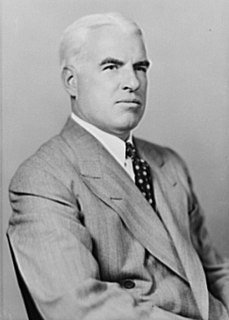 W
WThe National Recovery Administration (NRA) was a prime agency established by U.S. president Franklin D. Roosevelt (FDR) in 1933. The goal of the administration was to eliminate "cut throat competition" by bringing industry, labor, and government together to create codes of "fair practices" and set prices. The NRA was created by the National Industrial Recovery Act (NIRA) and allowed industries to get together and write "codes of fair competition." The codes intended both to help workers set maximum wages and maximum weekly hours, as well as minimum prices at which products could be sold. The NRA also had a two-year renewal charter and was set to expire in June 1935 if not renewed.
 W
WThe National Recovery Administration (NRA) was a prime agency established by U.S. president Franklin D. Roosevelt (FDR) in 1933. The goal of the administration was to eliminate "cut throat competition" by bringing industry, labor, and government together to create codes of "fair practices" and set prices. The NRA was created by the National Industrial Recovery Act (NIRA) and allowed industries to get together and write "codes of fair competition." The codes intended both to help workers set maximum wages and maximum weekly hours, as well as minimum prices at which products could be sold. The NRA also had a two-year renewal charter and was set to expire in June 1935 if not renewed.
 W
WPaul Howard Douglas was an American politician and Georgist economist. A member of the Democratic Party, he served as a U.S. Senator from Illinois for eighteen years, from 1949 to 1967. During his Senate career, he was a prominent member of the liberal coalition.
 W
WThe National Industrial Recovery Act of 1933 (NIRA) was a US labor law and consumer law passed by the 73rd US Congress to authorize the President to regulate industry for fair wages and prices that would stimulate economic recovery. It also established a national public works program known as the Public Works Administration (PWA), not to be confused with the Works Progress Administration (WPA) of 1935. The National Recovery Administration (NRA) portion was widely hailed in 1933, but by 1934 business' opinion of the act had soured. By March 1934 the “NRA was engaged chiefly in drawing up these industrial codes for all industries to adopt." However, the NIRA was declared unconstitutional by the Supreme Court in 1935 and not replaced.
 W
WHugh Samuel Johnson was a U.S. Army officer, businessman, speech writer, government official and newspaper columnist. He is best known as a member of the Brain Trust of Franklin D. Roosevelt in 1932–34. He wrote numerous speeches for FDR and helped plan the New Deal. Appointed head of the National Recovery Administration (NRA) in 1933, he was highly energetic in his "blue eagle" campaign to reorganize American business to reduce competition and raise wages and prices. Schlesinger (1958) and Ohl (1985) conclude that he was an excellent organizer, but that he was also domineering, abusive, outspoken, and unable to work harmoniously with his peers. The NRA was terminated by a 1935 ruling of the Supreme Court, and Johnson left the administration after a little more than a year.
 W
WdeLesseps Story Morrison, Sr., known as Chep Morrison, was an American attorney and politician, who was the 54th mayor of New Orleans, Louisiana from 1946 to 1961. He then served as an appointee of U.S. President John F. Kennedy as the United States ambassador to the Organization of American States between 1961 and 1963.
 W
WMargie Elizabeth Neal was a Texas journalist and politician. She was the first woman elected to the Texas State Senate, in 1926.
 W
WDonald Randall Richberg was an American attorney, civil servant, and author who was one of President Franklin D. Roosevelt's key aides and who played a critical role in the New Deal. He co-wrote the National Industrial Recovery Act, was general counsel and executive director of the National Recovery Administration. He also co-authored the Railway Labor Act, the Norris-LaGuardia Act, and the Taft-Hartley Act.
 W
WAlexander Sachs was an American economist and banker. In October 1939 he delivered the Einstein–Szilárd letter to President Franklin D. Roosevelt, suggesting that nuclear-fission research ought to be pursued with a view to possibly constructing nuclear weapons, should they prove feasible, in view of the likelihood that Nazi Germany would do so. This led to the initiation of the United States' Manhattan Project.
 W
WEdward Reilly Stettinius Jr. was an American businessman who served as United States Secretary of State under Presidents Franklin D. Roosevelt and Harry S. Truman from 1944 to 1945, and as U.S. Ambassador to the United Nations from 1945 to 1946.